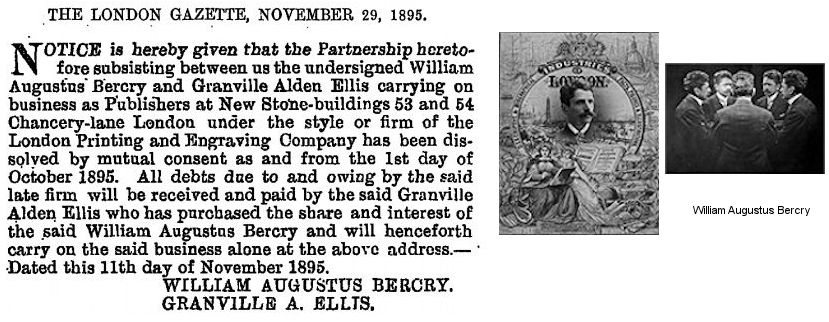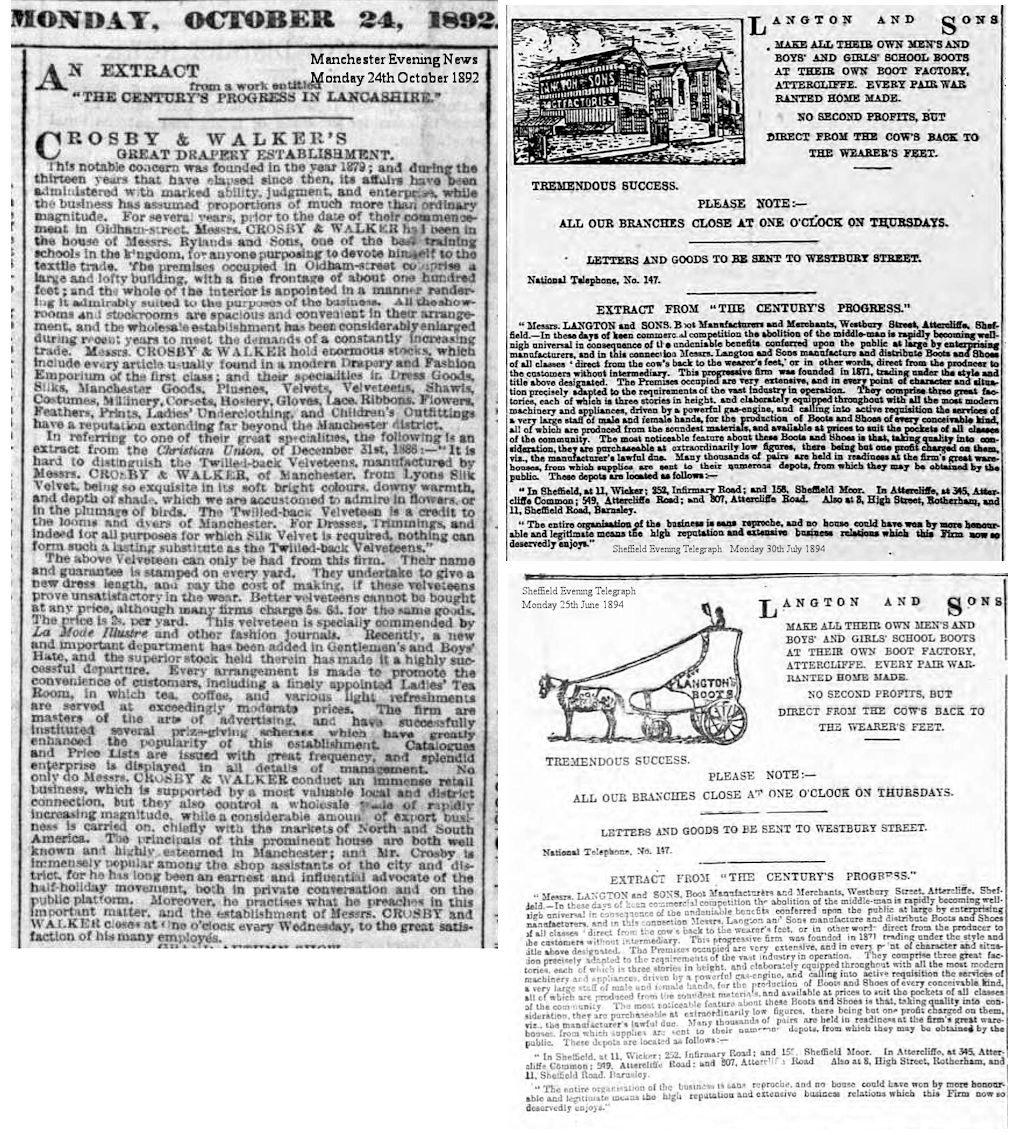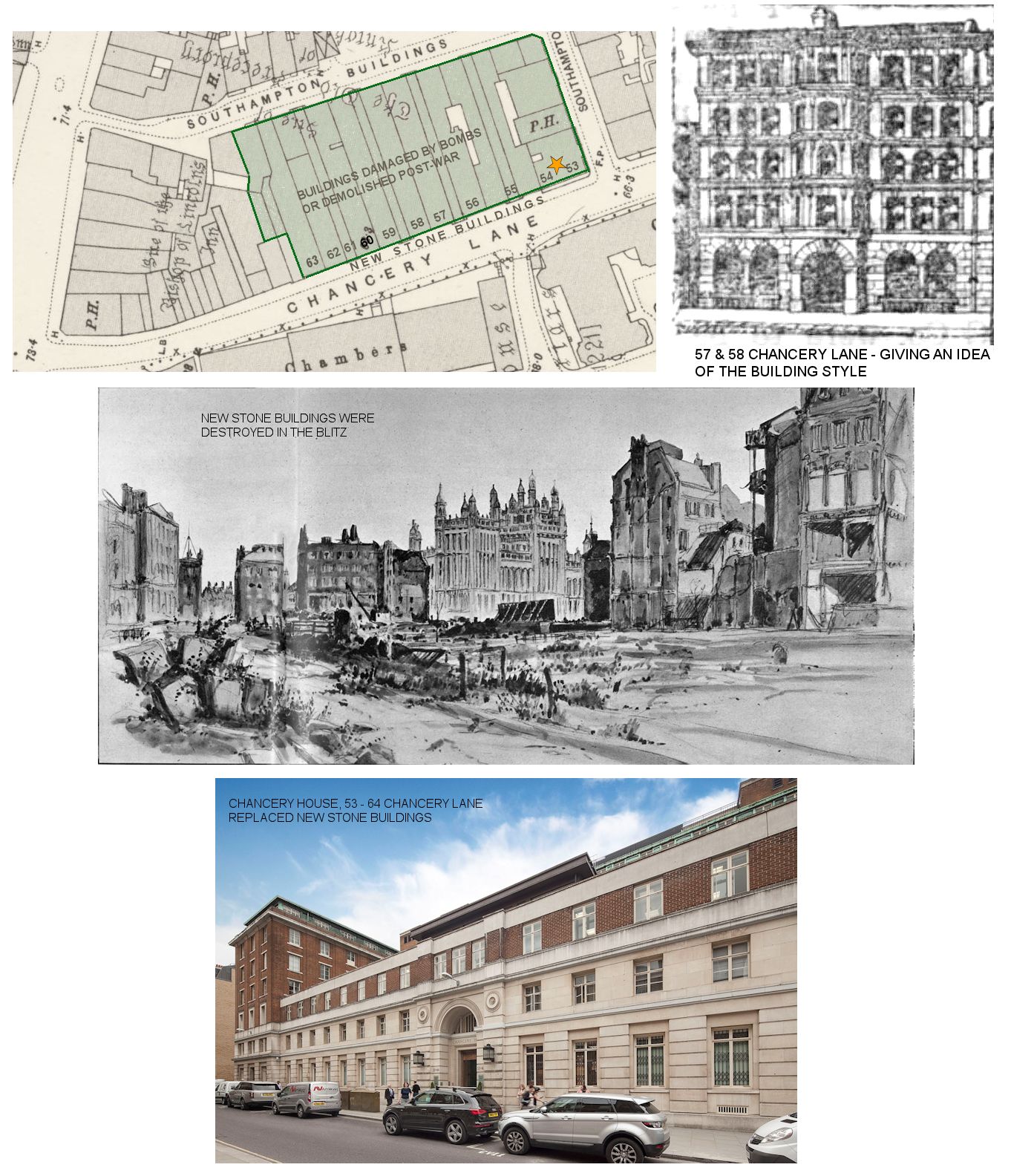I have 6 volumes by this company and this appears to be their entire output between 1892 (the first volume) and 1896 (company ceased trading). These are:
- Illustrated London and its Representatives of Commerce, 1893
- The Ports of the Bristol Channel: Progress Commerce 1893, Being a Directory of Merchants and Traders
- Century’s Progress: Lancashire
- Century’s Progress: Yorkshire 1893
- Industrial Great Britain a Commercial Review of Leading Firms Selected from Important Towns of England with Illustrations of England's Prominent Edifices, 1894
- Rivers of the North: Their Cities and Their Commerce: the Clyde, Forth, Tay, Tyne, and Tees: maritime enterprise, Manufacturing Energy, Mercantile Activity, 1894
These are all directories of "Representatives of Commerce" covering the region named in the title. The average length of the books is 250 pages, though the page numbering does not start from 1, which suggests that a local advertising section may have been inserted in some editions. They were intended to be an annual or periodical work. The opening section of each volume is an illustrated description of the region with statistics, notes on landmarks and illustrations, while the main section is a directory of the businesses that subscribed to the directory. This is repeated for each town covered by the volume. Judging from the styles of the descriptions, the companies either supplied their own notes (a mix of history and advertising) or weere interviewed by the book's writers. The styles of several writers are evident, but all the descriptions are flowery and wordy. All the firms are described as foremost in their trade (or words to that effect), which must have been awkward when there were six local businesses all described as foremost in the same trade.
A number of the entries are accompanied by engravings, occasionally photographs, of the premises. Generally the business were supplying the higher social classes, or particular local industries e.g. collieries (Bristol Channel) or shipbuilders (Rivers of the North). There were 2 different editions of each - a large and a small edition. I don't know the details of each edition, but at a guess the surviving books that I have scanned are the large editions. Copies would have been distributed to each subscriber, perhaps to circulate amongst their customers or give to a library to be referred to by a visitor. The subscriber would have paid the cost of typesetting and engraving blocks (if he did not provide his own block), and each volume was sold at 2 shillings. Some companies used extracts from the books as adverts placed in local papers.
My copy of "Illustrated London" cost only a few pounds at a car boot fair as a “tatty old book,” but better quality copies can cost around £100. Because it’s an important historical resource I have bought all 6 volumes, the most expensive costing £30, and scanned them all as a historical resource. The venture proved a failure and the publishers ceased trading and was wound-up in 1896. Although they were a failure at the time, the books are a window into commerce and consumerism in the late 19th Century.

They were not always received favourably by those who had subscribed to them, as this case mentioned in the Dundee Courier (Wednesday, 31st October, 1894), the Dundee Advertiser (same date) and other papers indicates.
The case was heard by Sheriff Campbell Smith in Dundee Small Debt Court on 30th October, 1894. The London Printing and Engraving Company, Chancery Lane, London (“the Company”) were pursuing a debt of £3 7s owed by J. Russell, 34 Gray Street, Broughty Ferry. This was the price of six copies of "The Rivers of the North, their Cities, and their Commerce" which contained an editorial notice of Russell's business at Broughty Ferry. Russell had placed an order for six copies of the book, and that when the books were sent to him he refused to accept delivery of them. Russell stated that the books in question did not fulfil his expectations, and that he had returned the proof containing the description of his business, informing the Company that he did not want the books. The Sheriff asked what the errors in the book were, and quoted "No house possesses higher reputation than the one here noted," which was met with laughter.
Mr Thomas Buick, Russell’s solicitor, stated that the only expense incurred by the Company was in setting the type of the notice in question. Mr Blair, of Messrs Shiell & Small, solicitors for the Company, stated that the market price of the books was about 2s each. Mr Buick said the notice was supposed to have appeared in hundreds of the smaller editions of the book, and the Company had failed to keep that end of their promise. The Sheriff said this was an action for breach of contract. Russell explained that he was induced to enter into the contract by misrepresentation, as the editorial notice of his business was to appear in all the books that would circulate in Broughty Ferry. The Sheriff put aside the claim of misrepresentation because there was no written contract; if Mr Russell wanted to stipulate that the description of his business was to enter into all the books, he should have made a written contract to that effect.
The notice about Russell’s business contained engravings of boots and shoes, all uncommonly smart articles, and was about 2 and-a-half inches in length — a printer's "stickful." Russell wanted possession of the block (engraving). The Sheriff joked that such a small block of engravings might tempt the owners of many twinkling feet to travel to Broughty Ferry for their boots, which was met by laughter in the court. He gave a summary of the case and of the book. In addition to saying that no house possessed a higher reputation than Russell’s, there were various other emphatic statements in the same vein. The whole paragraph was bold and unhesitating advertising puff, and the Sheriff disliked seeing such "puffery" travelling through the world in the disguise of a literary discourse and account of the rivers of the north, their cities, and commerce. He never knew that Broughty Ferry counted as a city until saw the book, and it did not occur to him that the eight people mentioned in it — cabinet-makers, sanitary plumbers, and milliners — were all the important people to be found in Broughty Ferry. That was the opinion the Sheriff derived on reading the book for the first time. A book giving an account of the rivers the north was not a proper way to advertise businesses and he did not think Russell’s business deserved any special encouragement. The defendant, Russell, had entered into a bargain (contract) and must therefore pay something. The real question was what he should pay for his block and what the Company had done for him. Russell did not care about the literature describing other towns, but only the literature about Broughty Ferry. (Laughter.) The Sheriff awarded the Company half the sum they had sued for - £1 13s 6d - with no expenses.
The second article I found is also from 1894 and mentions a canvasser for a London Printing and Engraving Company. It appeared in various forms in the Exeter and Plymouth Gazette (Tuesday, 20th November, 1894), the Bridport News (Friday, 23rd November, 1894) and other local papers. The essence of the report was that on 19th November 1894, at Dorchester Borough Police-court, a Devon man named John Walter Pollard, who represented himself as agent for a well-known London Printing and Engraving Company, was charged with stealing a box of cigars, value 10s, from the King's Arms Hotel, Dorchester, the previous Friday evening. Pollard was supporting his wife and family in Devon, as well as his mother and his invalid sister in Exeter. He had visited the King's Arms that evening and was waited on by barmaid Adelia Moore. She was absent for a few minutes, and when she returned she noticed a box of cigars was missing and reported this to the police. Police Sergeant King arrested Pollard who confessed and who had sold the cigars to a hawker, Henry Neville for 3d. Neville appeared as a witness. Pollard pleaded guilty and stated he had been very drunk. He had never been in any trouble before. He had only been in his present situation for a fortnight as a canvasser, and if he were sent to prison he would lose his job and be unable to support his family. He implored the Magistrates to let him go, as he was willing to repay the cost of the cigars. The Magistrates were lenient, letting him off with a penalty of 15s. The police censured Henry Neville for purchasing stolen goods.

GRANVILLE A. ELLIS
Granville Alden Ellis, an American living in London, was a son of Captain Alden Ellis and had formerly lived in New Bedford, and then Boston, Massachusetts. He died in 1921. He married Anna Mai Bosler at St George's, Hanover Square on 30th June 1891. In American newspaper accounts of his wedding he was described as a literary luminary who was a member of one of the leading publishing firms in London. In 1895, he became sole proprietor of the London Printing and Engraving Company, and in 1896 the company was wound up. In 1908, the couple lived at 48 Lexham Gardens, Kensington, London. In 1911, he was described in the American press as a wealthy London publisher. Anna Bosler, of Dayton, Ohio in 1857, was also an American living in London. She was a music and theatre critic, authoress and journalist known to American readers as Max Elliot. She contributed to a number of American newspapers as their London correspondent. She died at her country home “Pentwynn,” Freshwater, Isle of Wight, 1911. Granville and Anna Ellis had only one child, Violet May Granville Ellis, who married Charles Cecil Gwynedd Roberts at Kensington Parish Church in 1904.
WILLIAM AUGUSTUS BERCRY
All I could find about William Augustus Bercry was the name of a publication called “Industries of London” and a possible date of death in 1926.
53 AND 54 CHANCERY-LANE, LONDON
The company’s registered office was New-stone buildings, 53 and 54 Chancery-lane, London. I couldn’t find an image of that address (most references to New-stone - or new Stone’s building - are to 63 and 64), but I found an engraving of neighbouring 55 – 56 Chancery Lane which was probably similar. 53 and 54 Chancery-lane was subdivided into offices and the company the address with various other businesses, including barristers and share-dealers. New-stone Buildings (or new Stone’s Buildings) was apparently rather dreary with its dimly gaslit staircase and multiple floors. It was already over 100 years old at the time the London Printing and Engraving Co had offices there; there is an account from 1790 of the building’s copper roof covering being torn off by high winds. This part of Chancery Lane was destroyed in the WWII blitz. The modern, 53 and 54 Chancery Lane are part of Chancery House which has a nondescript post-World War II facade, the lower part being faced in stone and the upper part being red brick.
Underneath 53 and 54, and adjacent addresses, are the London Silver Vaults, which were originally established in 1882 and which contained strong-boxes rented monthly or annually by clients. These subterranean vaults survived the blitz. In 1953, several jewellery and silver dealers who had used the vaults for storage moved their shops to these vaults. Today the vaults contain a complex of 42 shops and booths selling antique jewellery and silver.
